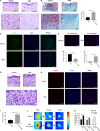Monotropein promotes angiogenesis and inhibits oxidative stress-induced autophagy in endothelial progenitor cells to accelerate wound healing
- PMID: 29278309
- PMCID: PMC5824424
- DOI: 10.1111/jcmm.13434
Monotropein promotes angiogenesis and inhibits oxidative stress-induced autophagy in endothelial progenitor cells to accelerate wound healing
Erratum in
-
.J Cell Mol Med. 2021 Nov;25(21):10322-10325. doi: 10.1111/jcmm.16995. J Cell Mol Med. 2021. PMID: 34747104 Free PMC article. No abstract available.
Abstract
Attenuating oxidative stress-induced damage and promoting endothelial progenitor cell (EPC) differentiation are critical for ischaemic injuries. We suggested monotropein (Mtp), a bioactive constituent used in traditional Chinese medicine, can inhibit oxidative stress-induced mitochondrial dysfunction and stimulate bone marrow-derived EPC (BM-EPC) differentiation. Results showed Mtp significantly elevated migration and tube formation of BM-EPCs and prevented tert-butyl hydroperoxide (TBHP)-induced programmed cell death through apoptosis and autophagy by reducing intracellular reactive oxygen species release and restoring mitochondrial membrane potential, which may be mediated viamTOR/p70S6K/4EBP1 and AMPK phosphorylation. Moreover, Mtp accelerated wound healing in rats, as indicated by reduced healing times, decreased macrophage infiltration and increased blood vessel formation. In summary, Mtp promoted mobilization and differentiation of BM-EPCs and protected against apoptosis and autophagy by suppressing the AMPK/mTOR pathway, improving wound healing in vivo. This study revealed that Mtp is a potential therapeutic for endothelial injury-related wounds.
Keywords: angiogenesis; autophagy; endothelial progenitor cells; wound healing.
© 2017 The Authors. Journal of Cellular and Molecular Medicine published by John Wiley & Sons Ltd and Foundation for Cellular and Molecular Medicine.
Figures










References
-
- Eberhardt RT, Raffetto JD. Chronic venous insufficiency. Circulation. 2014; 130: 333–46. - PubMed
-
- Valencia IC, Falabella A, Kirsner RS, et al Chronic venous insufficiency and venous leg ulceration. J Am Acad Dermatol. 2001; 44: 401–24. - PubMed
-
- Gurtner GC, Werner S, Barrandon Y, et al Wound repair and regeneration. Nature. 2008; 453: 314–21. - PubMed
-
- Asahara T, Kawamoto A. Endothelial progenitor cells for postnatal vasculogenesis. Am J Physiol Cell Physiol. 2004; 287: C572–9. - PubMed
-
- Bluff JE, Ferguson MW, O'Kane S, et al Bone marrow–derived endothelial progenitor cells do not contribute significantly to new vessels during incisional wound healing. Exp Hematol. 2007; 35: 500–6. - PubMed
Publication types
MeSH terms
Substances
LinkOut - more resources
Full Text Sources
Other Literature Sources
Medical
Miscellaneous

